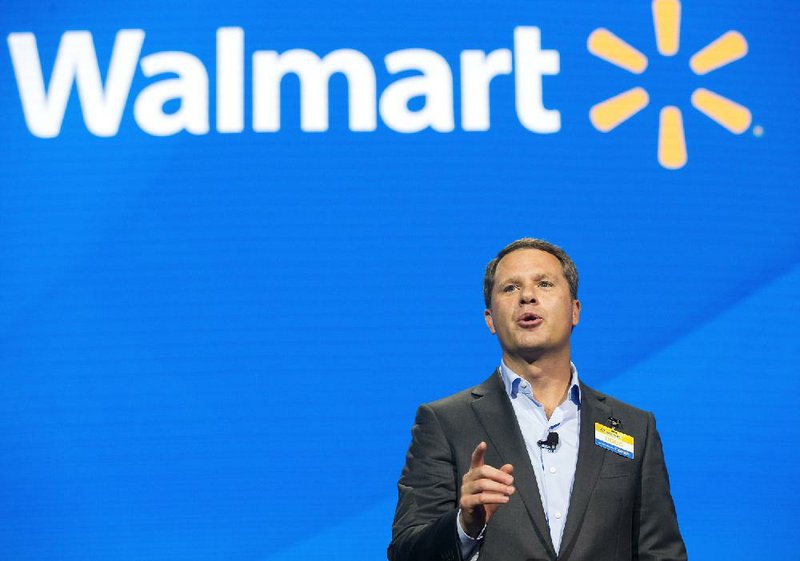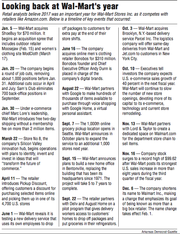Neil Stern will remember 2017 as the year Wal-Mart Stores Inc. made a philosophical change in its battle with online giant Amazon.com. The Bentonville retailer went on the offensive.
Stern, senior partner at Chicago-based retail consulting firm McMillan-Doolittle, said the shift showed in the many moves Wal-Mart made throughout the course of a busy year. There were acquisitions of online retailers like Bonobos, unlikely partnerships with companies like Google, and initiatives aimed at taking advantage of Wal-Mart’s biggest strength in retail: its 4,700 U.S. stores.
“In prior years they were kind of reacting to Amazon and being defensive,” Stern said. “This was the first year where whatever those moves are individually — like whether you think Bonobos is a good idea or a bad idea — it’s not something you would’ve expected from Wal-Mart.
“They’re no longer doing the predictable thing, and I think it’s paying off,” Stern said.
An eventful year for Wal-Mart in its ongoing transformation under Chief Executive Officer Doug McMillon and his executive team is coming to a close. Looking back at 2017, retail analysts like Stern believe the company took an aggressive and much-needed approach to evolve from a big-store retailer to a digitally driven company capable of creating a seamless experience for customers whether they choose to shop in Wal-Mart’s stores or across any of its collection of online sites.
Wal-Mart executives maintain that the company still has much to accomplish moving forward, and there were numerous signs of progress throughout the year. One of the most recent was the company reporting its strongest U.S. sales increase in more than eight years during the third quarter of the fiscal year. Wal-Mart’s stock has reached record heights as well, hovering close to $100 per share as the year ends. It’s trading roughly 43 percent higher than it was at the beginning of the year.
Sucharita Mulpuru, a retail analyst at Forrester Research, said it all points to what should be remembered as a “great year” for the company, especially as other retailers and department stores have struggled to hold on to market share under the weight of Amazon’s continued growth.
“They’ve always been a powerhouse in retail, but the narrative was that they were being displaced by Amazon,” Mulpuru said of Wal-Mart. “I think that this year has successfully reversed that narrative. This year is not about being displaced by Amazon. It is now like King Kong vs. Godzilla.”
One key step actually took place in 2016, when Wal-Mart acquired Jet.com for $3.3 billion and brought founder Marc Lore on board as the company’s U.S. e-commerce chief. Lore’s first full year with the company featured a handful of moves and innovative plans.
Wal-Mart acquired online retailers Shoes.com, Moose-jaw, ModCloth and Bonobos to improve its online assortment and give the company expertise in high-margin categories. The number of items available on Walmart.com has jumped to more than 70 million, roughly three times more than a year ago.
Under Lore, Wal-Mart introduced initiatives like free two-day shipping without a membership fee and pickup discount, which offers lower prices on items if customers are willing to order them online and collect them at a store. The company is also using employees to deliver items for extra pay at a handful of stores, while a grocery delivery partnership with ride-hailing services like Uber expanded to additional markets. Wal-Mart also installed pickup towers at a few hundred stores this year, and its online grocery pickup services is now available at about 1,000 locations.
PARTNERSHIPS
Then there were partnerships. Wal-Mart is working with Deliv and August Home on a small test in Silicon Valley that gives delivery workers access to customers’ homes to drop off packages. Google and Wal-Mart have teamed up to make items available to purchase through voice shopping with Google Home, a virtual personal assistant. Department store chain Lord & Taylor is working with Wal-Mart to have a dedicated space to sell merchandise on Walmart.com.
“Their ability to think out of the box and to be more open to these ideas — whether it’s partnerships or acquisitions — that’s quite different,” Stern said.
It’s unknown whether the strategy will work long term, but Wal-Mart’s digital sales grew 50 percent in the third quarter. Meanwhile, same-store sales were up 2.7 percent and traffic increased 1.5 percent. Stern believes accomplishing both is “spectacular” and shows the online and store businesses are starting to work together, and Mulpuru said it appears Wal-Mart’s bets are paying off.
“Everything they have sort of bet on is seemingly coming to fruition,” Mulpuru said. “Marc Lore has given them a ton of credibility, and they are innovating at a pace that I’ve never seen before. People are talking about them as a positive innovation force, which is exactly what they need because that puts them in the same conversation as Amazon and it helps [Wall Street] sort of see them differently.”
THE COSTS OF GROWTH
The growth still comes at a cost. Investments in technology and e-commerce continue to weigh on the company’s profits — net income was down 42 percent in the third quarter — and Wal-Mart has searched for ways to cut costs. That has included job cuts at the corporate level throughout the year.
But Brian Yarbrough, a retail analyst with Edward Jones, said Wall Street is evaluating Wal-Mart in a different light. As a result, the stock’s performance this year has been “pretty amazing.”
Wal-Mart’s stock opened the year at $69.24 and closed trading Thursday at $99.40.
“When you go back and look at their expectations starting for the year and where they finished up, it’s not like they’ve had some gangbuster year from a sales and earnings standpoint,” Yarbrough said. “But what I would say, this has gone from a stock where people questioned, ‘Can they compete with Amazon?’ to ‘They definitely can compete.’ Now it’s Amazon, Wal-Mart and everyone else.”
Yarbrough doesn’t expect another 40 percent growth for Wal-Mart’s stock next year, but he and other analysts expect the company to continue to accelerate plans to boost the business.
In October, Wal-Mart said during its annual meeting for the investment community that it expects U.S. e-commerce sales growth of 40 percent in the next fiscal year. Adjusted earnings per share are expected to grow 5 percent during fiscal 2019 with a net sales increase of 3 percent. Wal-Mart will expand its grocery pickup service to another 1,000 locations as well, while new-store growth will continue to slow as more capital is poured into technology, e-commerce and remodeling current stores.
“We’re stronger as a company. We have momentum,” McMillon said in November. “And we have more opportunities to leverage our unique assets to serve customers.”
WHAT’S AHEAD
Annibal Sodero, an assistant professor at the University of Arkansas, predicts more acquisitions as companies like Wal-Mart and Amazon continue to remove competitors from the marketplace.
He said there will be a continued emphasis on unveiling and implementing final-mile delivery solutions as companies explore ways to get products to customers faster and more efficiently.
“Wal-Mart will have to start leveraging others’ resources — in addition to its own network of stores — to make final mile deliveries in 2018,” Sodero said in an email. “So you should expect to see more partnership announcements, with Wal-Mart claiming that consumers will be able to pick their online purchases wherever they want and not only at a Wal-Mart store.”
Some evidence of Wal-Mart’s product-delivery efforts were clear late in the year when the company acquiring New York-based delivery service Parcel Inc. to offer same-day deliveries to customers in New York City. A couple of months later, Target Corp. acquired Alabama-based Shipt for $550 million.
Ken Perkins, president of Retail Metrics LLC, believes that Wal-Mart’s acquisition of Parcel — and whether the service will roll out on a larger scale in some form — will be intriguing to watch in 2018. So will the company’s emphasis on its pickup services. As Wal-Mart expands the number of pickup towers in stores and grocery pickup locations, Perkins said, the retailer must make sure the services operate with speed and efficiency to continue attracting customers.
But Perkins said Wal-Mart took important strides in 2017, which he described as a very creative, busy and successful year for the retailer.
“They really took Amazon seriously and have ramped up their game in order to compete long-term,” Perkins said. “It really accelerated this year.”
Wal-Mart executives maintain that the company still has much to accomplish moving forward, and there were numerous signs of progress throughout the year. One of the most recent was the company reporting its strongest U.S. sales increase in more than eight years during the third quarter of the fiscal year.


